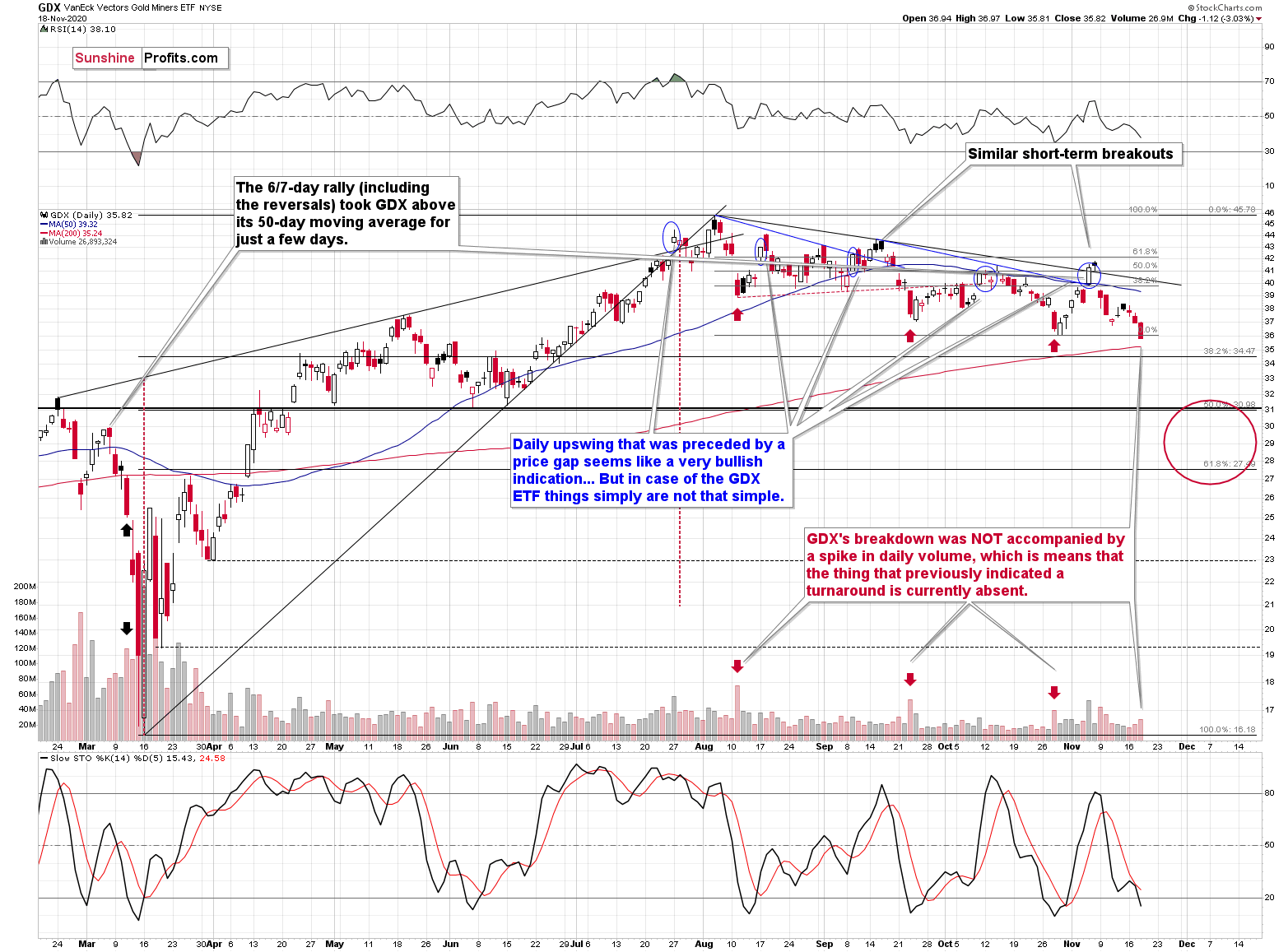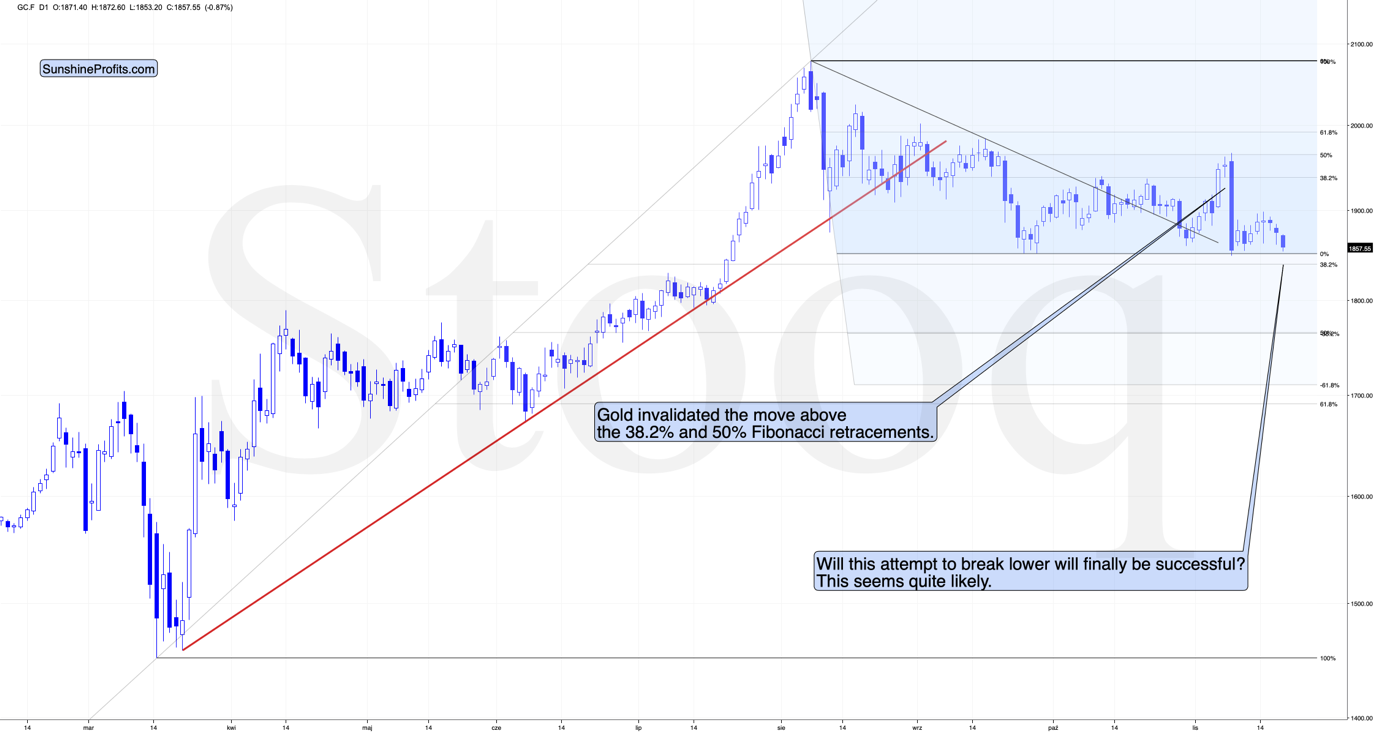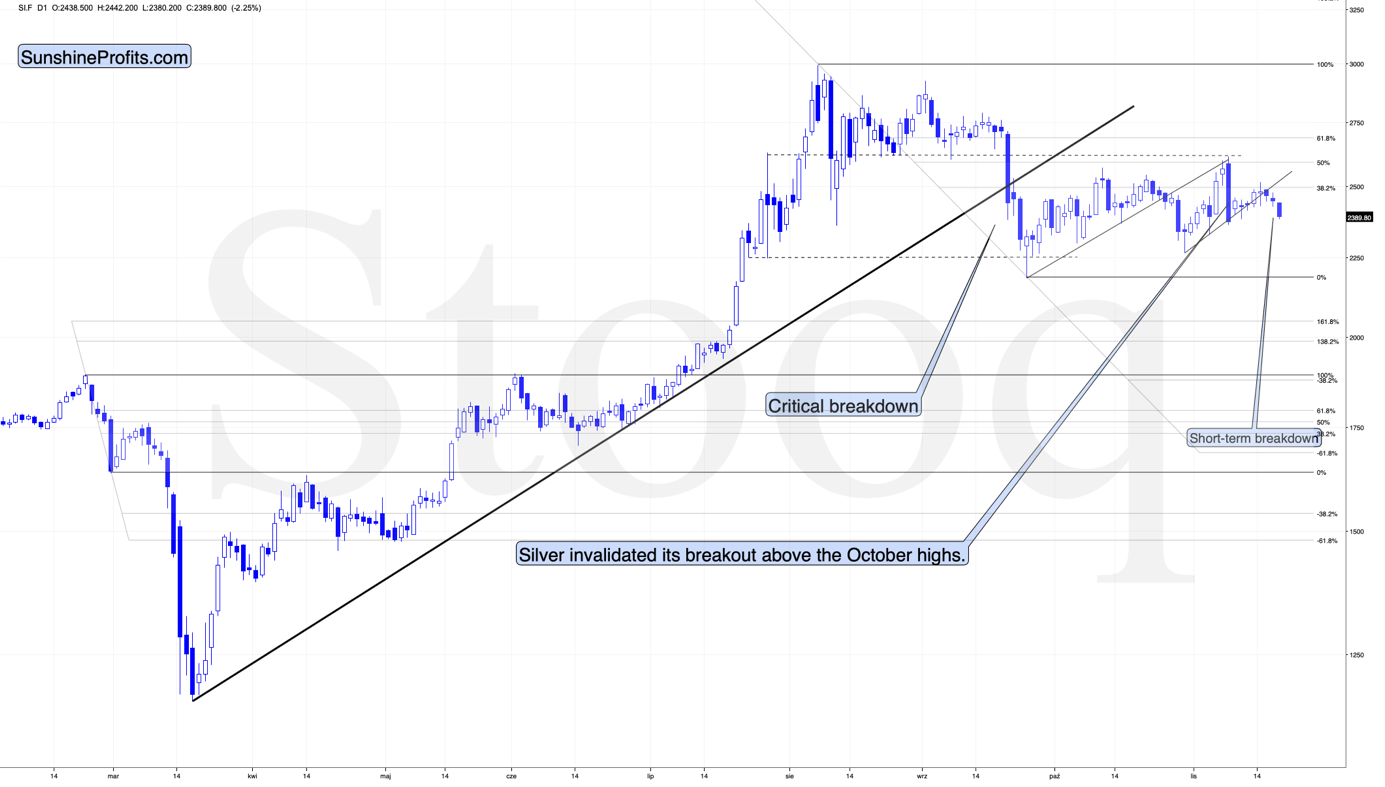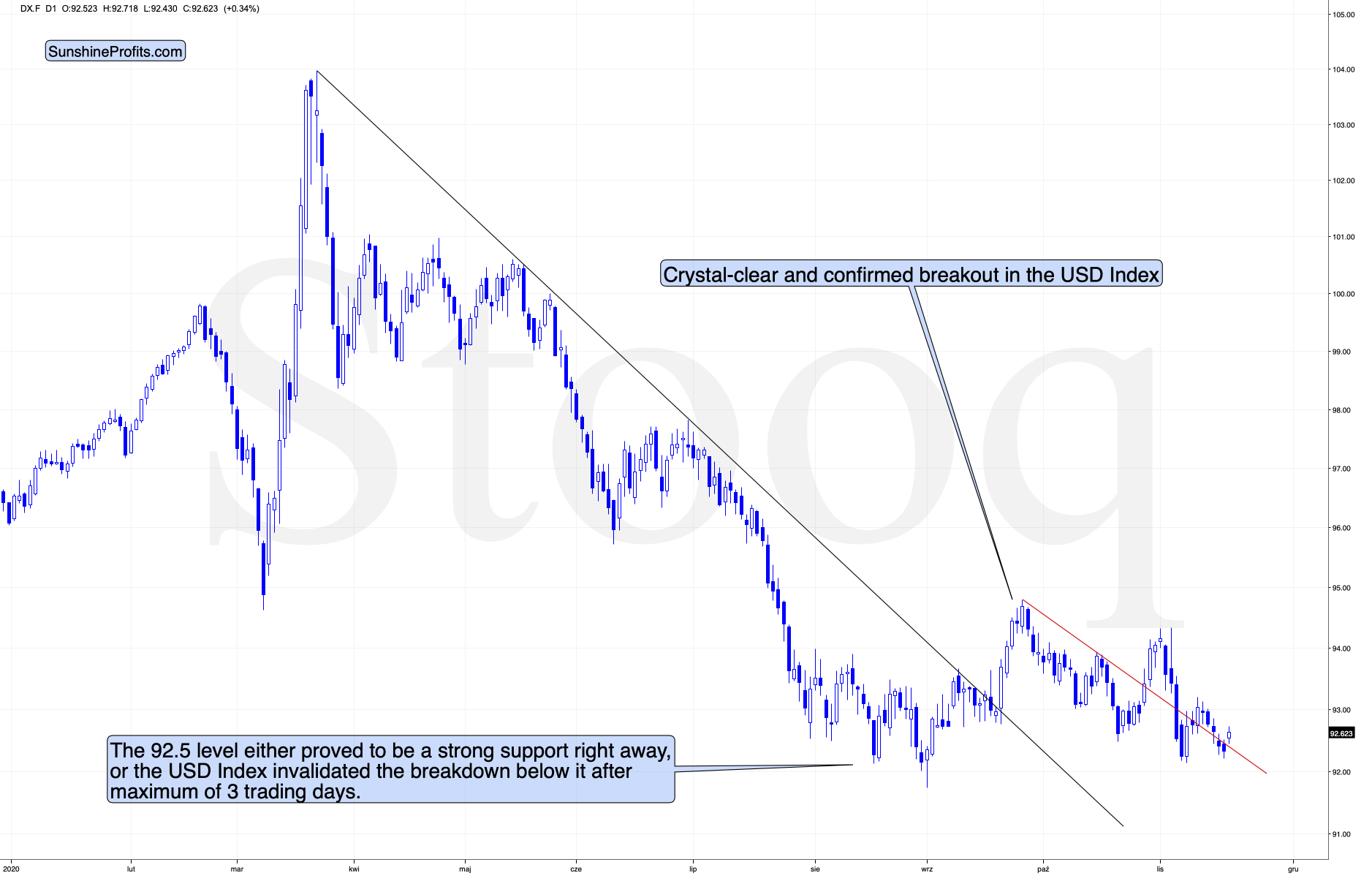Briefly: in our opinion, full (300% of the regular position size) speculative short positions in mining stocks are justified from the risk/reward point of view at the moment of publishing this Alert.
Remember the shortest movie theme ever created by John Williams and released in 1975? It was just a simple two-note motif. No? How about now: duunnn … dunn … duunnn … dunn … - that’s right, it was the theme from Jaws. John Williams’ genius was so great that he was able to create a rising tension with practically just that. Everyone knew that something was about to happen. Something major…something bad…and it was just beneath the surface.
This theme was the first thing that came to my mind when I saw where miners’ closed yesterday along with today’s pre-market action in gold, silver, and the U.S. Dollar Index.
Just like in the movie, when the theme first appeared without any shark attack, people could have viewed it as something suspicious, yet without a clear warning sign. After the first attack though, it was by then clear that this sound spells trouble. Similarly, what we see on the precious metals market right now is something we saw many times in the past and it meant big declines were just around the corner. The situation is also getting more similar to what we saw in the first quarter of the year, but in slow-motion.
Let’s take a closer look at the charts.
In yesterday’s analysis, I wrote the following about the above GDX ETF chart:
Let’s start today’s analysis by saying that miners have just closed at the second lowest daily close since early July.
This fact alone should make one question the validity of any bullish argument for the short term. Sure, gold, silver, and mining stocks have explosive potential for the following years. The world is likely to try to attempt to inflate its trouble away and gold is likely to greatly benefit from it along with the rest of the precious metals sector. But in the short term, markets can get ahead of themselves, just like they did in August. Then, they have to correct before rallying once again.
And if during these times they get a powerful bearish boost, for instance from rallying USD Index, the corrective downswing could be profound.
One more thing about the miners – please note that it’s the first time when the GDX ETF declined once again without a meaningful rally after bottoming near the $37 level. Both previous bottoms: the one that we saw in September and the one that we saw in late-October, were followed by rallies above $40. This time, the rally was tiny – and it was such even though the USD Index declined, and the general stock market moved higher in the last several days.
The short-term indications that I’ve been commenting on are pointing to the bigger decline having already started, but also being relatively far from being over. In fact, based on miners’ weak performance it seems that they just can’t wait to slide further.
Please note that yesterday was yet another day when miners moved higher initially only to decline during the day.
During yesterday’s session, miners declined over 3% and closed the day at their lowest level since late June. This happened without an analogous breakdown in gold or silver and without a major rally in the USD Index. It also happened without a huge slide in the main stock indices. Sure, the latter moved over 1% lower yesterday, but it doesn’t explain the breakdown in miners on its own. After all, stocks are very close to their all-time highs, while miners just moved to new lows.
And the volume? The volume was decent, but not particularly high. We didn’t see the spike in volume that occured on October 28, making us think that miners were about to start a counter-trend rally. No, this time the bulls didn’t put up a fight. It’s no wonder since they just failed to trigger a decent rally last week; it was evident that their strength is limited.
This is all an extremely strong confirmation that miners just can’t wait to move lower.
As I wrote earlier, gold is moving lower today, so the miners are likely to slide even more based on this move.
Gold didn’t move to new lows just yet, and it’s trying to catch up with miners today. Remember – yesterday’s breakdown in miners corresponded to the relatively calm action in gold – with gold moving lower, but recovering before the end of the day. Miners didn’t.
Back in 2013 and right before the big slide, miners were very weak relative to gold, and the same was the case in the first quarter of this year.
Silver broke below the rising short-term support line, but it’s not yet close to its recent lows. Just as I wrote yesterday and many times before, silver usually outperforms while miners underperform gold right before bigger declines, so the implications are bearish.
Moreover, please note that back in March, silver corrected 50% of the initial decline before really plunging. The September – November upswing corrected about 50% of September’s decline, which is quite similar to the previous pattern. Yes, this time the pattern took much more time to develop, but it’s quite normal given that right now the pandemic’s spread is more or less expected (at least it’s viewed as something within the range of “expected”), and it was new and unknown in the first part of the year.
The price drop that we see this time is therefore likely to be more moderate in terms of duration. The slide might not take just a few days, but rather a few weeks.
Before summarizing, let’s take a look at the USD Index.
The USDX has moved just a little higher today, and gold is already testing its previous lows. This is a very bearish combination of factors:
- The USDX is likely to soar as the sentiment is extremely bearish (everyone and their brother are expecting the USDX to move lower, so practically everyone who could have sold, has already done so), and the technical signs point to a major upswing (the broad bottom seems to be ending or it has already ended).
- Gold is likely to (at least initially) magnify signs coming from the USD Index, but in the opposite direction. We’re seeing this in today’s pre-market trading. The USDX is up by just a little, while gold is down more noticeably.
- Gold miners are likely to magnify gold’s bearish moves, at least initially. We’ve seen this taking place for some time now.
This is a profoundly bearish combination. While it’s not clear when exactly the breakdown in gold is going to take place, it’s very likely that we’ll see it shortly. Duunnn … dunn …
Overview of the Upcoming Decline
As far as the current overview of the upcoming decline is concerned, I think it has already begun.
During the final part of the slide (which could end later than in 6 weeks, perhaps near the end of the year – just like it happened in 2015), we expect silver to decline more than miners. That would align with how the markets initially reacted to the Covid-19 threat.
The impact of all the new rounds of money printing in the U.S. and Europe on the precious metals prices is incredibly positive in the long run, which does not make the short-term decline improbable. Markets can and will get ahead of themselves and decline afterward – sometimes very profoundly – before continuing with their upward climb.
The plan is to exit the current short positions in miners after they decline far and fast, but at the same time, silver drops just “significantly” (we expect this to happen in 0 – 5 weeks). In other words, the decline in silver should be severe, but the decline in the miners should look “ridiculous”. That’s what we did in March when we bought practically right at the bottom. It is a soft, but at the same time, a broad instruction, so additional confirmations are necessary.
I expect this confirmation to come from gold, reaching about $1,800. If – at the same time – gold moves to about $1,800 and miners are already after a ridiculously big drop (say, to $31 - $32 in the GDX ETF – or lower), we will probably exit the short positions in the miners and at the same time enter short positions in silver. It will be tempting to wait with opening the short position in silver until the entire sector rebounds, but such a rebound could last only a couple of hours, so it would be challenging to successfully execute such a strategy.
The precious metals market's final bottom is likely to take shape when gold shows significant strength relative to the USD Index. It could take the form of a gold’s rally or a bullish reversal, despite the ongoing USD Index rally.
Summary
Summing up, the next big move in the precious metals market is likely to be to the downside and – given the decrease in political uncertainty as well as previous Monday’s slide in gold, silver, and mining stocks – it seems that this move lower has already begun. The very weak performance of mining stocks in recent days confirms it.
As the USD Index appears to have ended forming its broad bottom pattern, it’s likely to rally, causing gold to slide. At some point gold is likely to stop responding to dollar’s bearish indications, and based on the above analysis, it seems that we might expect this to take place in December.
Naturally, everyone's trading is their responsibility. But in our opinion, if there ever was a time to either enter a short position in the miners or increase its size if it was not already sizable, it's now. We made money on the March decline, and on the March rebound, with another massive slide already underway.
After the sell-off (that takes gold to about $1,700 or lower), we expect the precious metals to rally significantly. The final decline might take as little as 1-6 weeks, so it's important to stay alert to any changes.
Most importantly, please stay healthy and safe. We made a lot of money on the March decline and the subsequent rebound (its initial part) price moves (and we'll likely earn much more in the following weeks and months), but you have to be healthy to enjoy the results.
As always, we'll keep you - our subscribers - informed.
To summarize:
Trading capital (supplementary part of the portfolio; our opinion): Full speculative short positions (300% of the full position) in mining stocks is justified from the risk to reward point of view with the following binding exit profit-take price levels:
Senior mining stocks (price levels for the GDX ETF): binding profit-take exit price: $32.02; stop-loss: none (the volatility is too big to justify a SL order in case of this particular trade); binding profit-take level for the DUST ETF: $28.73; stop-loss for the DUST ETF: none (the volatility is too big to justify a SL order in case of this particular trade)
Junior mining stocks (price levels for the GDXJ ETF): binding profit-take exit price: $42.72; stop-loss: none (the volatility is too big to justify a SL order in case of this particular trade); binding profit-take level for the JDST ETF: $21.22; stop-loss for the JDST ETF: none (the volatility is too big to justify a SL order in case of this particular trade)
For-your-information targets (our opinion; we continue to think that mining stocks are the preferred way of taking advantage of the upcoming price move, but if for whatever reason one wants / has to use silver or gold for this trade, we are providing the details anyway. In our view, silver has greater potential than gold does):
Silver futures downside profit-take exit price: unclear at this time - initially, it might be a good idea to exit, when gold moves to $1,703.
Gold futures downside profit-take exit price: $1,703
Long-term capital (core part of the portfolio; our opinion): No positions (in other words: cash
Insurance capital (core part of the portfolio; our opinion): Full position
Whether you already subscribed or not, we encourage you to find out how to make the most of our alerts and read our replies to the most common alert-and-gold-trading-related-questions.
Please note that we describe the situation for the day that the alert is posted in the trading section. In other words, if we are writing about a speculative position, it means that it is up-to-date on the day it was posted. We are also featuring the initial target prices to decide whether keeping a position on a given day is in tune with your approach (some moves are too small for medium-term traders, and some might appear too big for day-traders).
Additionally, you might want to read why our stop-loss orders are usually relatively far from the current price.
Please note that a full position doesn't mean using all of the capital for a given trade. You will find details on our thoughts on gold portfolio structuring in the Key Insights section on our website.
As a reminder - "initial target price" means exactly that - an "initial" one. It's not a price level at which we suggest closing positions. If this becomes the case (like it did in the previous trade), we will refer to these levels as levels of exit orders (exactly as we've done previously). Stop-loss levels, however, are naturally not "initial", but something that, in our opinion, might be entered as an order.
Since it is impossible to synchronize target prices and stop-loss levels for all the ETFs and ETNs with the main markets that we provide these levels for (gold, silver and mining stocks - the GDX ETF), the stop-loss levels and target prices for other ETNs and ETF (among other: UGLD, DGLD, USLV, DSLV, NUGT, DUST, JNUG, JDST) are provided as supplementary, and not as "final". This means that if a stop-loss or a target level is reached for any of the "additional instruments" (DGLD for instance), but not for the "main instrument" (gold in this case), we will view positions in both gold and DGLD as still open and the stop-loss for DGLD would have to be moved lower. On the other hand, if gold moves to a stop-loss level but DGLD doesn't, then we will view both positions (in gold and DGLD) as closed. In other words, since it's not possible to be 100% certain that each related instrument moves to a given level when the underlying instrument does, we can't provide levels that would be binding. The levels that we do provide are our best estimate of the levels that will correspond to the levels in the underlying assets, but it will be the underlying assets that one will need to focus on regarding the signs pointing to closing a given position or keeping it open. We might adjust the levels in the "additional instruments" without adjusting the levels in the "main instruments", which will simply mean that we have improved our estimation of these levels, not that we changed our outlook on the markets. We are already working on a tool that would update these levels daily for the most popular ETFs, ETNs and individual mining stocks.
Our preferred ways to invest in and to trade gold along with the reasoning can be found in the how to buy gold section. Furthermore, our preferred ETFs and ETNs can be found in our Gold & Silver ETF Ranking.
As a reminder, Gold & Silver Trading Alerts are posted before or on each trading day (we usually post them before the opening bell, but we don't promise doing that each day). If there's anything urgent, we will send you an additional small alert before posting the main one.
Thank you.
Sincerely,
Przemyslaw Radomski, CFA
Editor-in-chief, Gold & Silver Fund Manager







